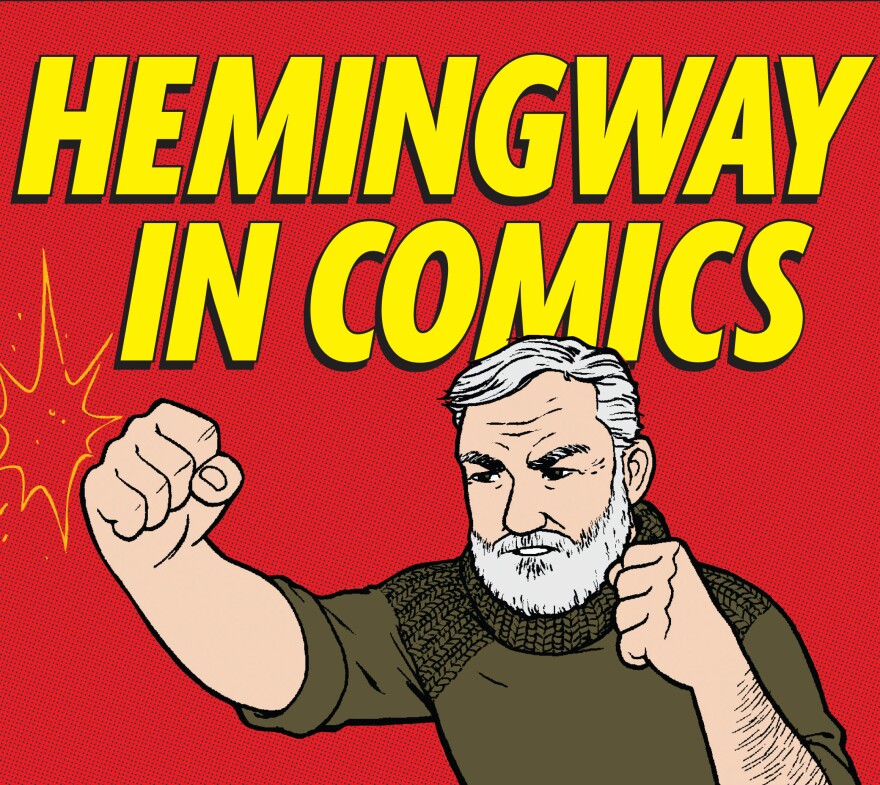Comic-Con Museum recently opened “Hemingway in Comics," an exhibit that explores what it means to be an icon and how that image can change over time. The exhibit is inspired by Robert K. Elder's book of the same title.
Writer Ernest Hemingway may be as famous for his lean, influential literary style as for a larger than life public image that he carefully curated.
Robert K. Elder was inspired to write "Hemingway in Comics" after seeing a German cartoon depicting Hemingway as a Disney character along with Donald Duck, Scrooge McDuck and Huey, Dewey, and Louie. That prompted Elder to look for other pop culture appearances of the author.

"He shows up in a Superman comic in the 1970s. He shows up in an Italian Mickey Mouse cartoon circa the year 2000. He shows up in a Jazz Age Creeper series," Elder said. "So because he was a fascinating person who lived in really fascinating times, it makes him the perfect sort of historical avatar to sort of speak for these times or to sort of be a cameo."
Elder had previously written "Hidden Hemingway," a biography told through objects and ephemera that Hemingway had kept. Elder's "Hemingway in Comic" highlights more than 120 Hemingway appearances from 18 countries. And the context for some of these appearances surprised Elder.
"Because I had already been sort of steeped in Hemingway history and biographies, I was surprised to learn is the level of some of the scholarship in Peter Milligan's story arc in 'Shade, The Changing Man,'" Elder said. "Hemingway shows up and it makes a reference to the fact that he was dressed as a little girl as a kid, and he was. He was twinned with his sister, and his sister was also dressed as a little boy. And so it's the different scholarly takes and historical takes on Hemingway because some of them are reverent, some of them love Hemingway (but) some of them absolutely make fun of him. So I just love this sort of range of takes on Hemingway because the book ultimately is about what happens when you become larger than life, when your name becomes a brand, when your persona outshines your work and you lose control of your myth."
The exhibit tries to look at Hemingway in all his complexities and flaws. Elder disputes charges of misogyny against Hemingway but admits that Hemingway curated a myth of hypermasculinity and was known to use language that was antisemitic.

"But we should make that part of the larger picture," Elder said. "There's also a piece to him which is strangely relevant, strikingly relevant, because he experimented with gender fluidity. (With) all of his wives, he sort of role swapped. With Mary Hemingway, his fourth wife, he called her his 'kitten brother,' and he often referred to himself as 'Catherine,' as the female part of the relationship. So in this time, when we're talking about trans rights and trans identity, he is strangely relevant in those conversations. So my hope is that people would see him as a whole person with flaws and sometimes huge flaws. But I think some of the myth doesn't have lasting teeth. Like some of the misperceptions don't help understand him as a human being or as an artist."
The original art from 40 of Hemingway's appearances in comics is now on display at Comic-Con Museum as part part of its Hemingway in Comics exhibit that runs through the end of the year. It is a fascinating look at an influential, acclaimed and sometimes controversial artist through a pop culture lens.
For Hemingway on film I suggest Woody Allen's "Midnight in Paris" and Bob Yari’s "Papa Hemingway in Cuba." Plus there is the Ken Burns and Lynn Novick three-part documentary "Hemingway" that is an excellent exploration of the author and his work.






